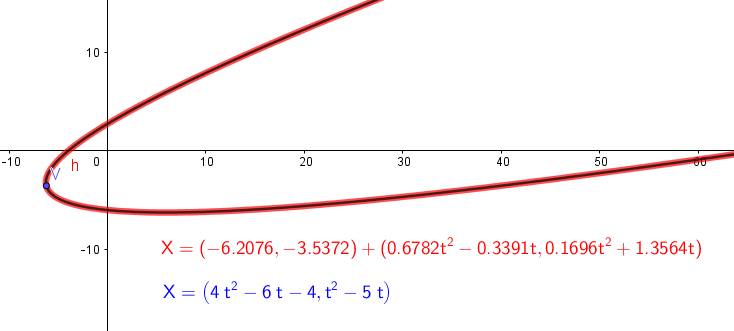Standard Parametric Form for a Parabola
If we know the Vertex, $V$, Angle of Rotation, $\theta$, and focal length, $p$, we can put the parabola into a standard form. $$\left(\begin{array}{c} x\\ y \end{array}\right)=\left(\begin{array}{c} V_{x}\\ V_{y} \end{array}\right)+\left(\begin{array}{cc} \cos\theta & -\sin\theta\\ \sin\theta & \cos\theta \end{array}\right)\left(\begin{array}{c} 2pt\\ pt^{2} \end{array}\right)$$ There is perhaps some advantage to this form. It separates and identifies the vertex, the rotation angle, and the focal length. The parameter $t$ is zero at the vertex of the parabola. Note this is different from other parametrizations, which may be easier to write but not display all this information.
Answer: Let's get the vertex first. Also we will be replacing $\tau$ with $t$. Remember, they are both parameters but since we will be parametrizing differently, they are not the same. The vertex is found by minimizing the magnitude of the tangent vector. First we get the tangent vector by simply differentiating $\mathbf{r}$. $$\mathbf{r'}=\left(\begin{array}{c} 8t-6\\ 2t-5 \end{array}\right)$$ Then we need the magnitude of the tangent vector. $$\Vert\mathbf{r'}\Vert=\sqrt{\left(8t-6\right)^{2}+\left(2t-5\right)^{2}}=\sqrt{68t^{2}-116t+61}$$ Next we need to minimize that magnitude, $$\frac{d\Vert\mathbf{r'}\Vert}{dt}=\frac{68t-58}{\sqrt{68t^{2}-116t+61}}=0.$$ Solving for $$t=\frac{29}{34}.$$ Now we put that into $\mathbf{r}$ to get $$\left(\begin{array}{c} 4\left(\frac{29}{34}\right)^{2}-6\left(\frac{29}{34}\right)-4\\ \left(\frac{29}{34}\right)^{2}-t\left(\frac{29}{34}\right) \end{array}\right)=V=\left(\begin{array}{c} -\frac{1794}{289}\\ -\frac{4089}{1156} \end{array}\right)\approx\left(\begin{array}{c} -6.21\\ -3.54 \end{array}\right).$$ Next we need to get $\theta$. $$\lim_{t\rightarrow\infty}\frac{t^{2}-5t}{4t^{2}-6t-4}=\frac{1}{4}=-\cot\theta$$ $$\theta=-\tan^{-1}(4)\approx-1.326$$ Aside: If we wanted to rotate this to the vertical, we would use $\phi=-\theta$ $$\left(\begin{array}{c} x\\ y \end{array}\right)=\left(\begin{array}{cc} \cos\phi & -\sin\phi\\ \sin\phi & \cos\phi \end{array}\right)\left(\begin{array}{c} 4\tau^{2}-6\tau-4\\ \tau^{2}-5\tau \end{array}\right).$$ At this point we can show the standard form, but we don't have $p$ yet. $$\left(\begin{array}{c} x\\ y \end{array}\right)=\left(\begin{array}{c} V_{x}\\ V_{y} \end{array}\right)+\left(\begin{array}{cc} \cos\theta & -\sin\theta\\ \sin\theta & \cos\theta \end{array}\right)\left(\begin{array}{c} 2pt\\ pt^{2} \end{array}\right) \tag{1} \label{1}$$ What we will do next is to pick a random point on the parabola to get som values for $(x,y)$. From $$\left(\begin{array}{c} 4\tau^{2}-6\tau-4\\ \tau^{2}-5\tau \end{array}\right)$$ let $\tau=1$ then $$\left(\begin{array}{c} x\\ y \end{array}\right)=\left(\begin{array}{c} 4-6-4\\ 1-5 \end{array}\right)=\left(\begin{array}{c} -6\\ -4 \end{array}\right)$$ Show $\eqref{1}$ with numbers. $$\left(\begin{array}{c} -6\\ -4 \end{array}\right)=\left(\begin{array}{c} -\frac{1794}{289}\\ -\frac{4089}{1156} \end{array}\right)+\left(\begin{array}{cc} 0.2425 & +0.9701\\ -0.9701 & 0.2425 \end{array}\right)\left(\begin{array}{c} 2pt\\ pt^{2} \end{array}\right) \tag{2} \label{2}$$ The rotation matrix for this is equivalent to (recall $\theta = -tan^{-1}(4)$) $$R=\left(\begin{array}{cc} \cos(\theta) & -\sin(\theta)\\ \sin(\theta) & \cos(\theta) \end{array}\right)=\left(\begin{array}{rr} \frac{1}{17}\;\sqrt{17} & \frac{4}{\sqrt{17}}\\ -\frac{4}{\sqrt{17}} & \frac{1}{17}\;\sqrt{17} \end{array}\right)$$ So eq. $\eqref{2}$ becomes $$\left(\begin{array}{c} -6\\ -4 \end{array}\right)=\left(\begin{array}{c} -\frac{1794}{289}\\ -\frac{4089}{1156} \end{array}\right)+\left(\begin{array}{rr} \frac{1}{17}\;\sqrt{17} & \frac{4}{\sqrt{17}}\\ -\frac{4}{\sqrt{17}} & \frac{1}{17}\;\sqrt{17} \end{array}\right)\left(\begin{array}{c} 2pt\\ pt^{2} \end{array}\right).$$ Now we can view this as two equations in variables $p$ and $t$ and solve for them simultaneously to get $p$. $$-6=4\;p\;\frac{t^{2}}{\sqrt{17}}+\frac{2}{17}\;\sqrt{17}\;p\;t-\frac{1794}{289}$$ $$-4=\frac{1}{17}\;\sqrt{17}\;p\;t^{2}-8\;p\;\frac{t}{\sqrt{17}}-\frac{4089}{1156}$$ $$p=\frac{49\sqrt{17}}{289}\qquad t=\frac{5}{14}$$ $$p\approx0.6991$$
